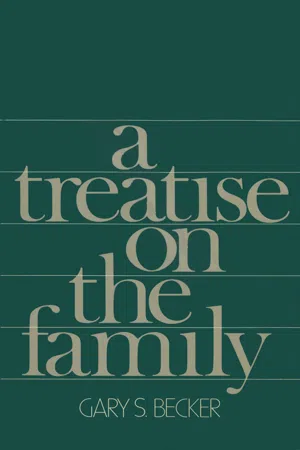
- English
- ePUB (mobile friendly)
- Available on iOS & Android
A Treatise on the Family
About This Book
Imagine each family as a kind of little factory—a multiperson unit producing meals, health, skills, children, and self-esteem from market goods and the time, skills, and knowledge of its members. This is only one of the remarkable concepts explored by Gary S. Becker in his landmark work on the family. Becker applies economic theory to the most sensitive and fateful personal decisions, such as choosing a spouse or having children. He uses the basic economic assumptions of maximizing behavior, stable preferences, arid equilibria in explicit or implicit markets to analyze the allocation of time to child care as well as to careers, to marriage and divorce in polygynous as well as monogamous societies, to the increase and decrease of wealth from one generation to another.The consideration of the family from this perspective has profound theoretical and practical implications. For example, Becker's analysis of assortative mating can be used to study matching processes generally. Becker extends the powerful tools of economic analysis to problems once considered the province of the sociologist, the anthropologist, and the historian. The obligation of these scholars to take account of his work thus constitutes an important step in the unification of the social sciences. A Treatise on the Family will have an impact on public policy as well. Becker shows that social welfare programs have significant effects on the allocation of resources within families. For example, social security taxes tend to reduce the amount of resources children give to their aged parents. The implications of these findings are obvious and far-reaching. With the publication of this extraordinary book, the family moves to the forefront of the research agenda in the social sciences.
Frequently asked questions
Information
Single-Person Households
Traditional Theory








Table of contents
- Cover
- Title
- Copyright
- Dedication
- Contents
- Preface to the Enlarged Edition
- Introduction
- 1 Single-Person Households
- 2 Division of Labor in Households and Families
- 3 Polygamy and Monogamy in Marriage Markets
- 4 Assortative Mating in Marriage Markets
- 5 The Demand for Children
- 6 Family Background and the Opportunities of Children
- 7 Inequality and Intergenerational Mobility
- 8 Altruism in the Family
- 9 Families in Nonhuman Species
- 10 Imperfect Information, Marriage, and Divorce
- 11 The Evolution of the Family
- Bibliography
- Index